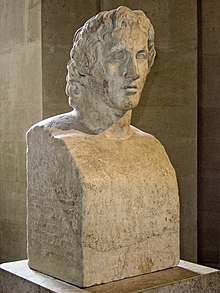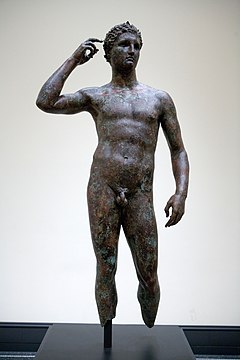Lysippos
Lysippos | |
|---|---|
 Head ofHeracleswearing akausia;Roman marble copy (135–150 CE) of Greek original (330–310 BC) attributed to Lysippos.Prado Museum,Madrid,Spain. | |
| Born | c. 390 BC |
| Died | c. 300 BC(aged around 90) Sicyon, Greece |
| Occupation | sculptor |
| Relatives | Lysistratus(brother) |
Lysippos(/laɪˈsɪpɒs/;Greek:Λύσιππος)[1]was aGreek sculptorof the 4th century BC. Together withScopasandPraxiteles,he is considered one of the three greatest sculptors of theClassical Greekera, bringing transition into theHellenistic period.Problems confront the study of Lysippos because of the difficulty in identifying his style in the copies which survive. Not only did he have a large workshop and many disciples in his immediate circle,[2]but there is understood to have been a market for replicas of his work, supplied from outside his circle, both in his lifetime and later in theHellenisticandRomanperiods.[3]TheVictorious Youthor Getty bronze, which resurfaced around 1972, has been associated with him.
Biography
[edit]Born atSicyonaround 390 BC, Lysippos was a worker inbronzein his youth. He taught himself the art of sculpture, later becoming head of the school ofArgosand Sicyon. According to Pliny, he produced more than 1,500 works, all of them in bronze. Commentators noted his grace and elegance, and thesymmetria,or coherent balance, of his figures, which were leaner than the ideal represented by Polykleitos and with proportionately smaller heads, giving them the impression of greater height. He was famous for his attention to the details of eyelids and toenails.
His pupil,Chares of Lindos,constructed theColossus of Rhodes,one of theSeven Wonders of the Ancient World.As this statue does not exist today, debate continues as to whether its sections were cast in bronze or hammered of sheet bronze.

Career and legacy
[edit]Lysippos was successor in contemporary repute to the famous sculptorPolykleitos.Among the works attributed to him are the so-calledHorses of Saint Mark,Eros Stringing the Bow(of which various copies exist, the best in theBritish Museum),Agias(known through the marble copy found and preserved inDelphi), the similarOil Pourer(DresdenandMunich), theFarnese Hercules(which was originally placed in theBaths of Caracalla,although the surviving marble copy lies in theNaples National Archaeological Museum) andApoxyomenos(orThe Scraper,known from aRomanmarble copy in theVatican Museums). Lysippos was also famous for his bronze colossal sculptures of Zeus, 17 metres tall, and Herakles, seven meters seated, both from the city ofTaras.The only remaining version of one such statue is a Roman copy ofThe Weary Herakles (Farnese Hercules),by Glykon,[4]with heavy musculature typical of early third century Rome.
Canon of Lysippos
[edit]Lysippos developed a moregracilestyle than his predecessorPolykleitosand this has become known as theCanon of Lysippos.[5]In hisHistoria Naturalis,Pliny the elderwrote that Lysippos introduced a newcanoninto art:capita minora faciendo quam antiqui, corpora graciliora siccioraque, per qum proceritas signorum major videretur,[6][a]signifying "a canon of bodily proportions essentially different from that of Polykleitos".[8]Lysippos is credited with having established the 'eight heads high' canon ofbody proportions.[9]
Lysippos and Alexander
[edit]
During his lifetime, Lysippos was personal sculptor toAlexander the Great;indeed, he was the only artist whom the conqueror saw fit to represent him.[10]An epigram byPosidippus,previously only known from theAnthology of Planudes(APl 119), but also found on the recently discoveredMilan Papyrus(65 Austin-Bastianini), takes as its inspiration a bronze portrait of Alexander:
And similarly, an epigram byAsclepiades(APl 120):
Lysippus modelled Alexander's daring and his whole form.
How great is the power of this bronze! The brazen king
seems to be gazing at Zeus and about to say:
"I set Earth under my feet; thyself, Zeus, possess Olympus."[12]
Lysippos has been credited with the stock representation of an inspired, godlike Alexander with tousled hair and lips parted, looking upward[13]in what came to be known as the 'Lysippean gaze'. One fine example, an early Imperial Roman copy found atTivoli,is conserved at theLouvre.
The Victorious Youth
[edit]
In 1972, theVictorious Youth,Getty Bronze, orAtleta di Fanoto Italians, was discovered and at the urging of Paul Getty, bought by theGetty Museum.The bronze was pulled out of the sea and restored. Because of the amount of corrosion and the thick layer of incrustation that coated the statue when it was found, it can be assumed that it was beneath the water for centuries. This is less than surprising, as most of the classical bronze statues archeologists have found have been fished out of the Mediterranean Sea. It was not uncommon for a shipwreck to occur with something as precious as a sculpture on board. Without any way to find or retrieve them, these pieces were left to sit at the bottom of the ocean for centuries. The damaging corrosion can be removed by cleaning the surfaces mechanically with a scalpel.[15]
The Getty Bronze is believed by some to be Lysippos's work, or at least a copy, because the detail on it is consistent with his style of work and hiscanon of proportions.Lysippos's work is described by ancient sources as naturalistic with slender and often lengthened proportions, often with exaggerated facial features.[16]Those depicted in the works of Lysippos had smaller heads than those of his mentorPolykleitosbecause he used a one to eight scale for the head and the total height of the body.[17]
See also
[edit]
- Lysistratus,another Greek sculptor
Notes
[edit]- ^LatinizedLysippus(/laɪˈsɪpəs/) is less used today, even in English.
- ^His son Euthyktates worked in his style, according toPliny,and, in the next generation, Tysikrates produced sculpture scarcely to be distinguished from his. (Natural Historyxxxiv. 61-67).
- ^The rediscoveredAgias,dedicated by Daochos atDelphi,was a contemporarymarblecopy of a bronze. The original was atFarsalainThessaly.
- ^Stokstad, Marilyn. Art History: Ancient Art. Prentice Hall, 2011.
- ^Charles Waldstein, PhD. (17 December 1879).Praxiteles and the Hermes with the Dionysos-child from the Heraion in Olympia(PDF).p. 18.
The canon of Polykleitos was heavy and square, his statues werequadrata signa,the canon of Lysippos was more slim, less fleshy
- ^Pliny the Elder. "XXXIV 65".Historia Naturalis.cited in Waldstein (1879)
- ^George Redford,FRCS."Lysippos and Macedonian Art".A manual of ancient sculpture: Egyptian–Assyrian–Greek–Roman(PDF).p. 193.
- ^Walter Woodburn Hyde (1921).Olympic Victor Monuments and Greek Athletic Art.Washington: the Carnegie Institution of Washington. p. 136.
- ^"Hercules: The influence of works by Lysippos".Paris: TheLouvre.Retrieved4 October2020.
In the fourth century BCE, Lysippos drew up a canon of proportions for a more elongated figure that that defined by Polykleitos in the previous century. According to Lysippos, the height of the head should be one-eighth the height of the body, and not one-seventh, as Polykleitos recommended.
- ^Plutarch,Life of Alexander, iv
- ^Translation taken from C. Austin and G. Bastianini,Posidippi Pellaei quae supersunt omnia,Milan 2002, p. 89.
- ^Translation taken from W.R. Paton's Loeb edition,The Greek Anthology V,Cambridge, Massachusetts 1918, p. 227.
- ^The Search for Alexander,a1976exhibition catalogue, illustrates several examples and traces the development of the type.
- ^Frel, Jiří(1982).The Getty Bronze.California: The J Paul Getty Museum. p. 1.ISBN0-89236-039-9.
- ^Frel, Jiří (1982).The Getty Bronze.California: The J Paul Getty Museum. pp. 7–29.ISBN0-89236-039-9.
- ^"Lysippos: Ancient Greek Sculptor, Biography".visual-arts-cork.Retrieved19 November2015.
- ^"Hercules".louvre.fr.Retrieved4 October2020.
According to Lysippos, the height of the head should be one-eighth the height of the body, and not one-seventh, asPolykleitosrecommended.
References
[edit]- A. F. Stewart, "Lysippan Studies" 2. Agias and Oilpourer "American Journal of Archaeology82.3 (Summer 1978), pp. 301–313.
Further reading
[edit]- Gardner, P. 1905. 'The Apoxymenos of Lysippos',JHS25:234-59.
- Serwint, N. 1996. 'Lysippos', inThe Dictionary of Artvol. 19: 852–54.
- Stewart, A.F. 1983. 'Lysippos and Hellenistic sculpture',AJA87:262.
- Vermeule, C.C. 1975. 'The weary Herakles of Lysippos',AJA79:323–32.
